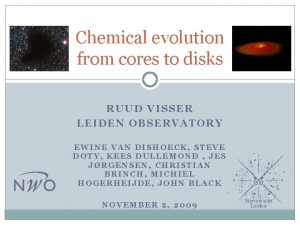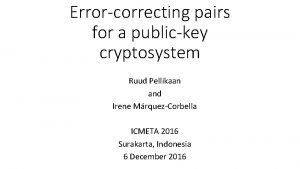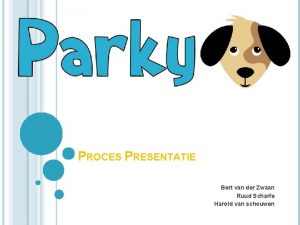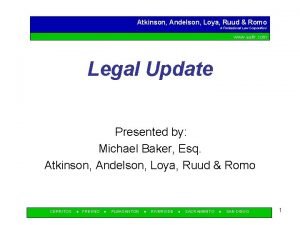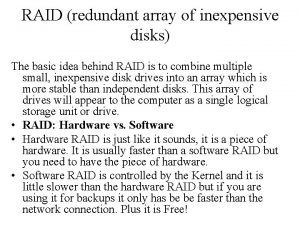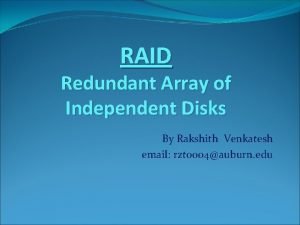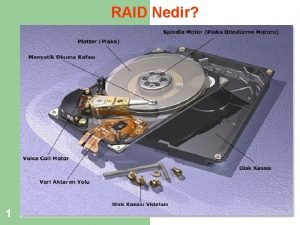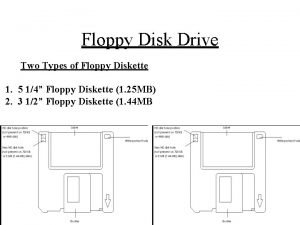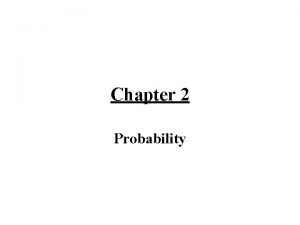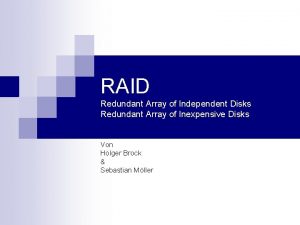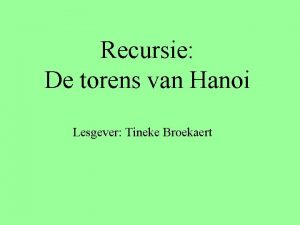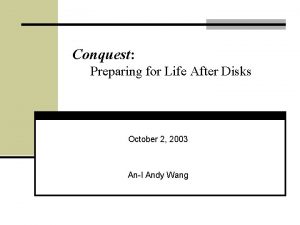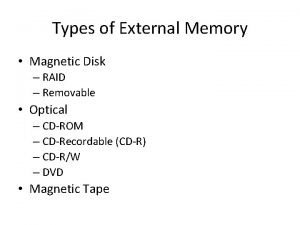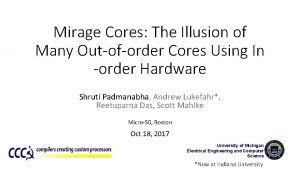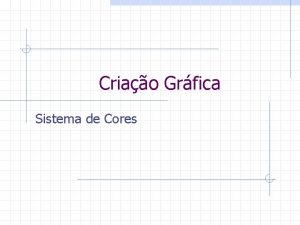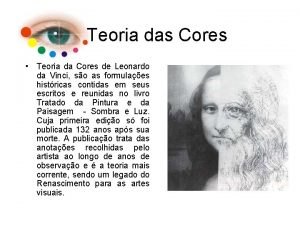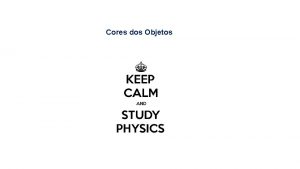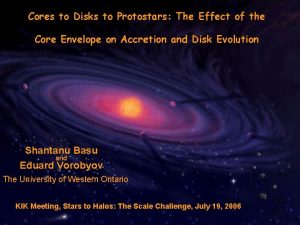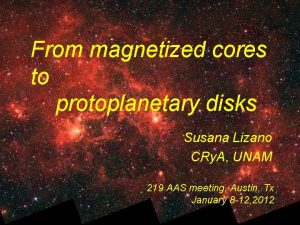Chemical evolution from cores to disks RUUD VISSER
























- Slides: 24

Chemical evolution from cores to disks RUUD VISSER LEIDEN OBSERVATORY EWINE VAN DISHOECK, STEVE DOTY, KEES DULLEMOND , JES JØRGENSEN, CHRISTIAN BRINCH, MICHIEL HOGERHEIJDE, JOHN BLACK NOVEMBER 2, 2009

Low-mass star formation Evolution of gas and dust Herbst & van Dishoeck (2009)

Main features of this study One model from pre-stellar core to circumstellar disk Two-dimensional, axisymmetric Study chemical evolution Goal in itself Chemistry affects physics: temperature, MRI, . . . Diagnostic tool

Motivation How do size and mass of disk evolve? When is the disk first formed? How does matter flow from envelope to disk? Explain observed cometary abundances Existing models treat only the envelope or only the disk, or both in 1 D often approximate temperature

Comets: a view of the past Error bars CO HCN CH 3 OH H 2 CO HNC HCOOH indicate spread between sources Dotted line: hypothetical one-to-one relationship Comets in general similar to ISM, but individual differences exist Bockelée-Morvan et al. (2000, 2004), Schöier et al. (2002)

Analytical star formation model in 2 D Fast to run, high resolution, easy to change initial conditions Cloud mass, rotation rate, sound speed, . . . Density & velocity: inside-out collapse Shu (1977), Terebey, Shu & Cassen (1984) Dust temperature (important!) from full radiative transfer RADMC: Dullemond & Dominik 2004 Physics compare well with hydrodynamical models Yorke & Bodenheimer 1999, Brinch et al. 2008 a, b Density profiles compare well with observations Jørgensen et al. 2009 Visser et al. (2009), Visser & Dullemond (subm. ), Visser et al. (in prep. )

From one to two dimensions streamlines disk surface Previous collapse models treated disk as completely flat Include vertical structure: accretion occurs further out Visser & Dullemond (subm. )

Where does material go to? Inside-out collapse gives a layered disk Start of collapse End of collapse into star/ outflow Visser et al. (2009)

Infall trajectories Need to solve chemistry dynamically: compute n, T along many trajectories Many different trajectories Jump in n, T upon entering disk Visser et al. (2009) , Visser et al. (in prep. )

Chemical evolution along one trajectory outflow wall A: volatiles evaporate (e. g. CO, N 2) B: intermediates evaporate (e. g. CH 4, NO) infall trajectory disk surface C: other ices evaporate (e. g. H 2 O, NH 3, CH 3 OH) photodissociation of many species D: some species reformed Visser et al. (in prep. )

Chemical zones: CO gas/ice Start of collapse End of collapse into star/ outflow Red: CO remains adsorbed (pristine!) Green: CO desorbs and re-adsorbs Pink: CO desorbs and remains desorbed Blue: multiple desorption/adsorption Visser et al. (2009)

Chemical evolution of water Before collapse: water frozen out onto cold dust H 2 Oice H 2 O O H 2 Oice H 2 O 1. Always frozen 2. Evaporates, photodissociated, reformed, freezes out 3. Evaporates, photodissociated, reformed 4. Evaporates, photodissociated 5. Evaporates 6. Evaporates, freezes out, evaporates 7. Evaporates, freezes out Visser et al. (in prep. )

Chemical evolution of water Before collapse: water frozen out onto cold dust 1. Always frozen 2. Evaporates, photodissociated, reformed, freezes out 3. Evaporates, photodissociated, reformed 4. Evaporates, photodissociated 5. Evaporates 6. Evaporates, freezes out, evaporates 7. Evaporates, freezes out Visser et al. (in prep. )

Chemical evolution of water Before collapse: water frozen out onto cold dust Comet-forming zone 1. Always frozen 2. Evaporates, photodissociated, reformed, freezes out 3. Evaporates, photodissociated, reformed 4. Evaporates, photodissociated 5. Evaporates 6. Evaporates, freezes out, evaporates 7. Evaporates, freezes out Visser et al. (in prep. )

Implications for comets Dotted line: HCOOH CO HNC HCN H 2 CO CH 3 OH grain-surface chemistry hypothetical one-to-one relationship Many model abundances differ from cometary abundances Suggestive of mixing or grainsurface chemistry? Visser et al. (in prep. )

Another application of our model: dust Carbonaceous material Graphite (small-scale limit: PAHs) Hydrogenated amorphous carbon Diamonds Silicates Amorphous (olivine, pyroxene, . . . ) Crystalline (forsterite, enstatite, . . . ) Ices H 2 O, CO 2, CH 3 OH, NH 3, . . .

From crystalline to amorphous and back up to 50% crystalline 0– 2% crystalline up to 50% crystalline 1– 30% crystalline

Dust processing ISM: 1% crystalline; disks: 1– 30% crystalline Crystallization by thermal annealing requires 800 K Works for material accreting close to the star Crystalline silicates observed down to 150 K and in comets formed in 100– 200 K regions How can we explain these cold crystalline silicates?

Disk evolution model Inside-out collapse with rotation Dust accreting in hot inner region is crystallized Disk spreads out to conserve angular momentum Crystalline material transported to colder areas Dullemond, Apai & Walch (2006), Visser & Dullemond (subm. )

Crystalline fractions Black: time 2006 model Red: new model obs. 0. 3 Myr 1. 0 Myr 3. 2 Myr Model results in good agreement with observed range! Visser & Dullemond (subm. )

Implications for comets Observations Model Silicate dust Partially crystalline Partially amorphous Chemical composition Generally similar to ISM Individual differences Partially crystalline Partially amorphous Chemical composition Outer disk unprocessed Inner disk processed Cometary material is of mixed origins

Caveats Gas temperature Gas-phase production of water Increase inner-disk scale height Shape of stellar spectrum Allow photodissociation of H 2, CO, N 2 Trapping of volatiles in water ice Increase ice abundances of CO, N 2, O 2, . . . Mixing Chemical zones in disk more diffuse Crystallinity paradox?

Future work Compute line profiles Compare with observations by SMA, JCMT, IRAM 30 m, . . . Analyse water data from Herschel (WISH key program) Make predictions for ALMA Add grain-surface chemistry Formation of complex organics Add isotope-selective CO photodissociation New model: Visser, van Dishoeck & Black (2009)

Conclusions First model to go from pre-stellar cores to circumstellar disks in 2 D Important to do collapse and disk formation in 2 D Disk is divided into zones with different chemical histories Outer part pristine, inner part processed Cometary material is of mixed origins
 Ruud visser
Ruud visser Ruud pellikaan
Ruud pellikaan Ruud bolle
Ruud bolle Maaike bomers advocaat
Maaike bomers advocaat Ruud zwaan bedrijf
Ruud zwaan bedrijf Atkinson, andelson, loya, ruud & romo
Atkinson, andelson, loya, ruud & romo Hydraulics karl lagerfeld
Hydraulics karl lagerfeld Sam siemssen
Sam siemssen Ingmar visser
Ingmar visser Bregtje visser
Bregtje visser Rien visser
Rien visser Who killed geertjen visser
Who killed geertjen visser Martien visser energie
Martien visser energie A mechanism that spins, reads, and writes disks.
A mechanism that spins, reads, and writes disks. Redundant arrays of inexpensive disks
Redundant arrays of inexpensive disks Redundancy array of independent disk
Redundancy array of independent disk Redundant array of independent disks
Redundant array of independent disks Types of floppy disks
Types of floppy disks Probability learning objectives
Probability learning objectives Holger brock
Holger brock Repeat
Repeat Duffy's mvp levels
Duffy's mvp levels Tower of hanoi 4 disks
Tower of hanoi 4 disks Conquest data disks
Conquest data disks Types of magnetic disks
Types of magnetic disks
